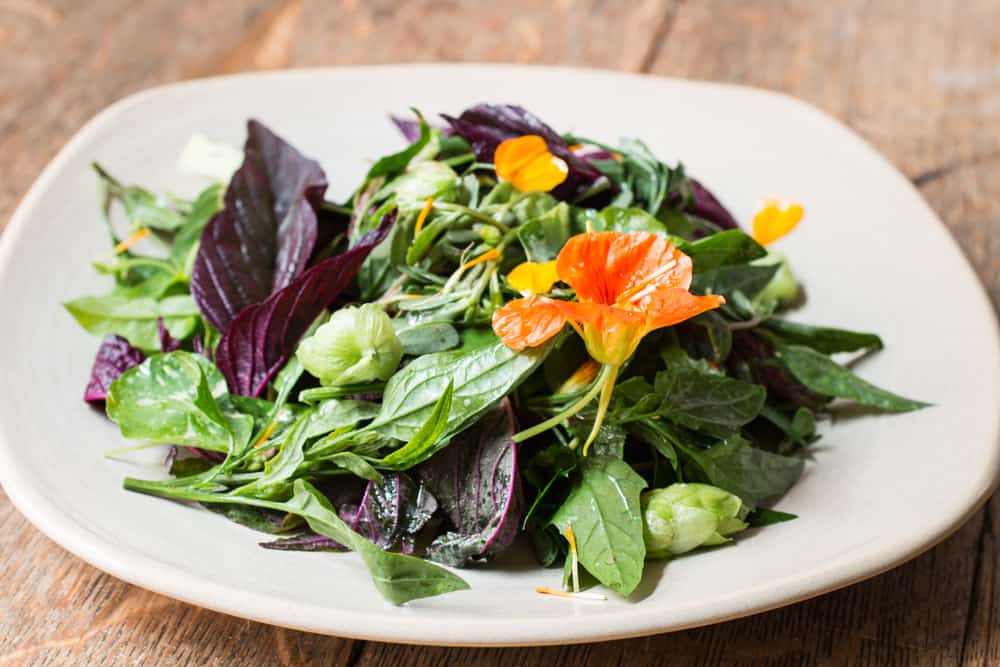You can make a delicious salad from wild edible plants, but there's a few things to know. Most importantly, your greens must be young, or at least the young growing parts of the plant, called meristems. Read on and I'll explain how it's made.

I never liked salads as a kid, they were always like watery, tasteless lettuce. If I ever did eat a salad it was assassinated with dressing, croutons and cheese, since it's hard to make fat, salt and carbs taste bad. Even through my teenage years and into college, I still wondered why people ate salads.

I didn't really understand what a salad could become until I tasted one made for me by my girlfriend one evening a few years ago. My girlfriend and her family live on a farm her mother Dotty started, filled with different gardens, some with lettuces, some filled with flowers and herbs, others on top of a hill have vegetables, there's about 5-6 in all.

My favorite gardens are the ones where she's allowed the wild greens to grow alongside the cultivated ones. Even the compost piles are like gardens in themselves, surrounded by thick carpets of chickweed and topped with the healthiest bushes of lamb's quarter, amaranth and nettles.
It's a place where wild greens are celebrated and eaten with just as much enthusiasm as any other green. Dotty still picks many of the greens herself, and brings around little care-packages to the rest of the family like a home-grown mesclun mix, but it's light years ahead of that the thin lettuces in a plastic box, bound to die a day or two after you purchase them.
Less is more
My girlfriend had opened up one of her mom's lettuce mixes to dress for dinner. She stirred together a simple dressing of mustard, vinegar, and oil, and a pinch of salt and pepper, then added the greens. I wasn't expecting anything crazy, I mean it's just salad right?
I took a bite. Here and there were bursts of flavor from whole herbs, a piece of basil here, a sprig of cilantro there. It was interesting, it was so simple. Most of all it was exciting, I'd never eaten anything like it. Whole clusters of lambs quarter and amaranth were like some kind of half-vegetable half-plant hybrid, crunchy with lots of texture and they didn't wilt and get soggy like typical lettuce. I remember slowing down, enjoying every bite, and then getting seconds.
To get the real effect of this, you won't want to use cultivated spring mix, or traditional lettuce, part of the fun is the texture of the young growth of all the different greens, punctuated by a few fresh herbs here and there. I never use the same ratios of greens twice, but I almost always use most of the same varieties. Here's some of my favorites to pick and choose from.
My Favorite Wild Salad Greens and Ingredients
- Amaranth
- Lamb's Quarter
- Jewelweed leaves and flowers
- Chickweed
- Purslane
- Dandelion greens and flowers (I always tear these into 1 inch pieces since the stem can be tough)
- Hop Buds
- Nasturtiums (technically cultivated I but I like them in the salad)
- Flowers, like marigolds, nasturtiums day lily, roses, borage, comfrey, violets, and milkweed
- Quickweed/Frenchweed
- Trout Lily and Ramp Leaves (available in Spring)
- Wild watercress (available in Spring)
- Blanched, marinated fiddlehead ferns, or pickled (in the Spring)

How to Make a Salad from Edible Wild Greens
Equipment
- 1 salad bowl
Ingredients
- 12 ounces mixed wild greens washed and dried
- Flowers to garnish, like day lilies, borage, and nasturtiums
- Fresh herbs to taste like cilantro or basil, torn
- Salad oil like extra virgin or virgin sunflower, to taste
- Balsamic or white balsamic vinegar You can also use other sweetened vinegars, see note
- Kosher salt and fresh ground black pepper to taste
Instructions
- Put the greens, flowers and herbs in a salad bowl, then drizzle with the oil and vinegar or lemon juice, salt and pepper to taste. Toss, then taste a bit to double check the seasoning for acid and salt, adjust as needed, then divide the salad equally between four chilled salad plates and serve immediately.


Joy
You can also use wild mustards and Lady's Thumb. The Lady's Thumb, especially, needs to be young leaves, but the older ones can be used as a cooked green.
Christopher Trella
Excellent article on how to make a truly wonderful salad using backyard and field plants!
Alan Bergo
Thanks Christopher.